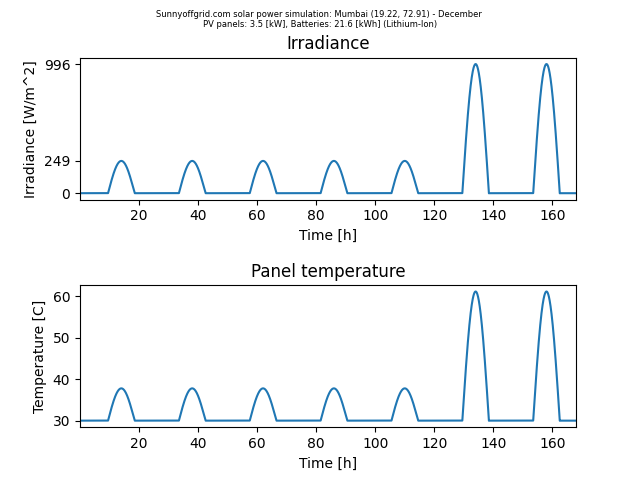When you order a solar energy calculation you need to submit:
- Your place in the world
- The energy consumption (in kWh) that you wish your solar power system to supply you with during each day
- Which months of the year you wish your solar power system to work without problems (more solar panels and batteries are needed for it to work during winter time)
- How many days of cloudy sun free weather you wish your system should be able to handle, without the batteries being fully discharged
You fill out these options at the page “Specify your order”, which you arrive at by clicking the basket at the top right in the meny. Your solar power system is then dimensioned by Sunny off-grid and an electrical simulation is performed in order to verify that the system works for the conditions you have specified. You receive the results in an e-mail: the suggested amount of panels and batteries as well as the graphs from the simulation.
Example: 2 kWh in Madrid with lead-acid batteries
In this example an off-grid solar power system for Madrid in Spain is dimensioned using lead-acid batteries, which should be able to provide 2 kWh of electrical energy per day. The solar power system should be able to provide this energy even if it the weather is rainy for 7 days in a row, for the months May to June. The batteries should be fully charged up again after 3 average days of average irradiance.
Conclusion: 750 W of solar panels and 17.28 kWh of lead-acid batteries should work fine.
| May |
| Input data |
 |
| Output data |
 |
| June |
| Input data |
 |
| Output data |
 |
Another example: 6 kWh in Mumbai with lithium-ion batteries
In this second example an off-grid system with lithium-ion batteries is dimensioned for Mumbai in India from September to December. The batteries should keep the state-of-charge higher than 20% during 5 rainy days and then be charged full again during 2 subsequent average days. The daily electrical household consumption is 6 kWh.
Conclusion: 3.5 kW of solar panels and 21.6 kWh of lead-acid batteries could do the job.
| September |
| Input data |
 |
| Output data |
 |
| October |
| Input data |
 |
| Output data |
 |
| November |
| Input data |
 |
| Output data |
 |
| December |
| Input data |
 |
| Output data |
 |
The simulation results have been verified
The simulation results of Sunny off-grid have been compared with simulations of possible solar power production around the world (see this graph), done by the World Bank. The results were almost identical, deviating only about 5 to 10 percent.

